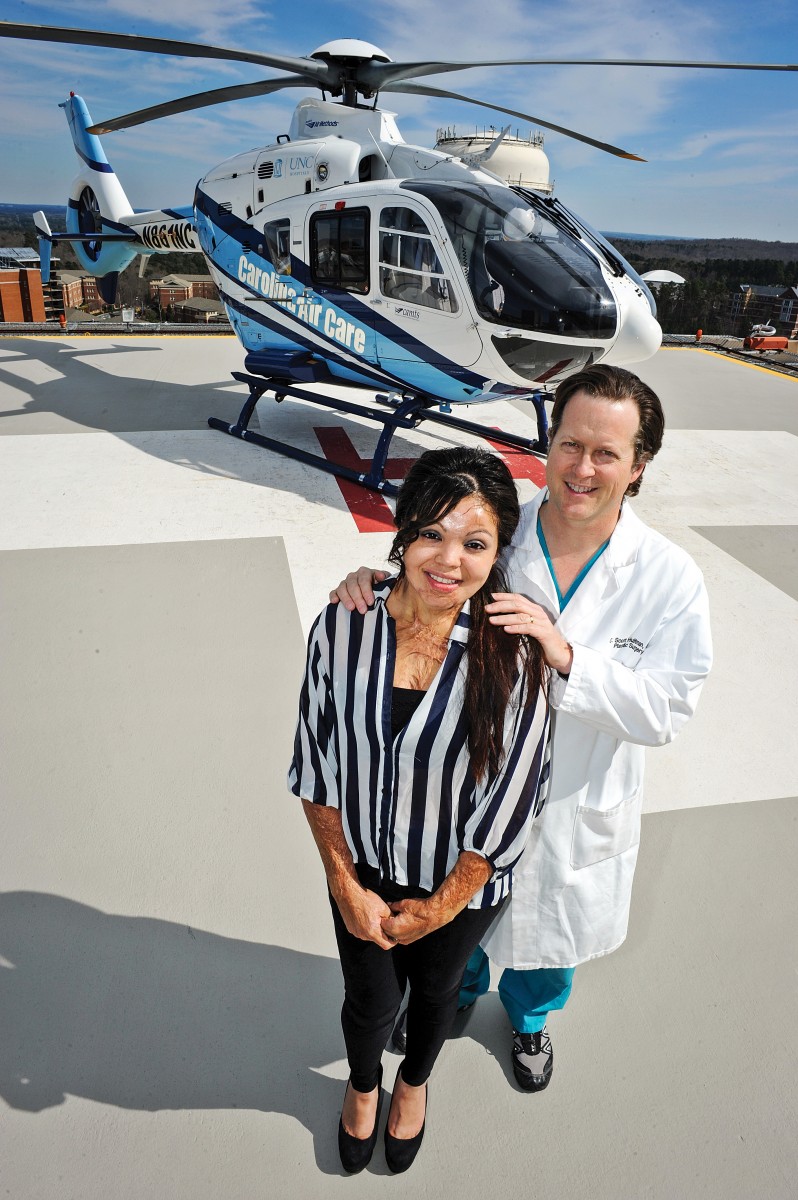Motivated by What’s Possible
Posted on Sept. 8, 2015
Cruz Maria Santibanez and Charles Hultman on the helipad at UNC Cruz Maria Santibanez ’14 hopes her surgeries will end soon. “That’s the problem of reconstruction,” says her plastic surgeon, Dr. Scott Hultman. “It gets in the way of your life.” (Photo by Dan Sears ’74)
Seven years have passed since the gas grill fire that left Cruz Maria Santibanez ’14 a regular patient at UNC’s Jaycee Burn Center, visibly scarred and irrepressibly determined to succeed as a journalist. She’d had about 30 surgeries before her graduation from what is now UNC’s School of Media and Journalism; overall, she has been to the operating table about 40 times.
When the Review profiled Santibanez in May/June 2013, she had decided to work in broadcast news, where she and her audience would have to get past the scars on her face, chest and hands. That hasn’t worked out quite as she had planned, but she still wants to work in front of a camera.
She received several on-camera reporting and producing job offers as she approached graduation. She started looking for an apartment. But in October 2014, a family member who later said she was jealous of Santibanez’s early career success accused her of trespassing and of simple assault. A judge found her not guilty of all charges, according to court records. But the charges remained on her record. The TV stations cut off further communication with her.
Meanwhile she is pursuing a dream — literally.
Santibanez has petitioned a district court to seal her record. Meanwhile, she’s following up on what happened when she awoke in the middle of the night in December 2014 and wrote several names down on a piece of paper. She’d have the same dream three times — each more exact and defined than the last and each almost exactly a month apart. After the third dream, she called the people on her list, including two of her Carolina classmates.
She asked them about conversations they’d had over the past few years, sitting in the dorm room and in the Undergraduate Library, when they’d talked about finding a way to help people heal from physical and internal scars. Each of them had different issues. Now they have a common desire to talk about them publicly, in the hope of inspiring others.
They began making plans for a YouTube channel show called “The Possible,” raising money through an online Indiegogo campaign and presenting their plan to potential private donors. The journalism school gave the women access to its broadcast set, and on Aug. 12 they launched a weekly show.
“I just so happen to be that girl that has the scars,” Santibanez said shortly before the show first aired. “But that’s just one-third of what the show will talk about, which is to change the stigma of the idea that if you’re different, you’re not accepted. Those with internal scars, if they don’t sit down and talk with you about what they’ve been through, you would never understand.”
Santibanez hopes that her summer surgery will be her last — a desire that could soon be a reality, according to her plastic surgeon, Dr. Scott Hultman.
“That’s the problem of reconstruction: It gets in the way of your life,” Hultman said. “So at some point you’ve reached that critical juncture where it’s not about the surgery anymore or about the procedures, but it’s about taking what you have and getting on with your life’s work.”
Santibanez said that work is “The Possible.”
“The vision is to help people connect to others through their stories,” Santibanez said. “And through that, to heal from their own pain.”
— Emily Palmer ’14, a former Review intern, is a New York-based writer.
Thanks for reading the Carolina Alumni Review
Carolina Alumni members, sign in to continue reading.
Not yet a member? Become one today.
